Is There Blue Green Algae in Groton Ma
It's alive!
Blue-green algae, that is.
And if you are not careful, this strange green slime can soon take over your entire tank.
Today, I am going to teach you everything there is to know about blue-green algae, including how to eliminate it altogether.
What is blue green-algae?
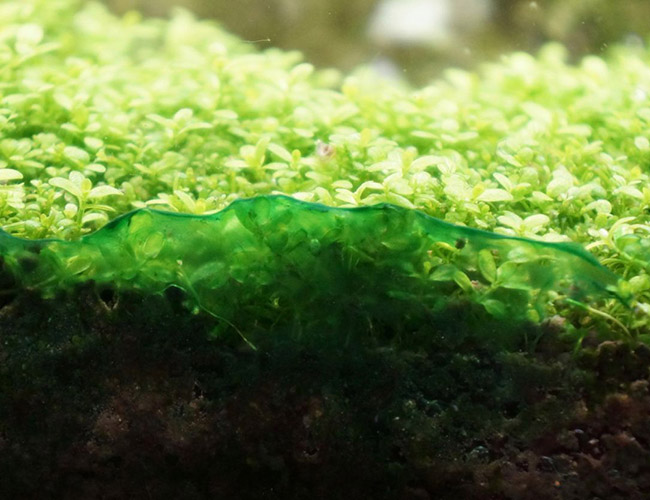
Given its name and looks, you would assume that blue-green algae is an algae, right?
I mean, it looks like algae…
And, it definitely feels like algae…
What else could it be?
Well, it turns out that blue-green algae isn't an algae at all. It's actually a bacteria called cyanobacteria.[1]
And as far as bacteria go, it's pretty weird.
This bacteria is believed to be over 2.3 billion years old. That's right, it was around well before dinosaurs roamed the earth.[2]
Many scientists believe that if it wasn't for the formation of cyanobacteria, humans may not exist!
Also, cyanobacteria are able to photosynthesize – that is, use light to create food. This is something typically only seen in plants.
And, here's what it looks like under a microscope.

If it wasn't such a pain, it would almost be beautiful, right?
As you see, cyanobacteria is named because of how it looks under a microscope, a lovely shade of cyan, which is a greenish-blue color.
But for the purpose of this guide, I refer to cyanobacteria as blue-green algae.
Why?
Well, the problem is that there are many different species of cyanobacteria. And each one is different.
In fact, the saltwater variant of cyanobacteria doesn't look blue/green at all. Instead, it's a slimy, reddish-brown color, as you see below…

Let's compare that to the cyanobacteria commonly found in freshwater aquariums…

Even though both of these are cyanobacteria, they look completely different, right?
Well, this guide is about freshwater cyanobacteria, specifically the type found in your aquarium. And to avoid any confusion, I'm going to refer to it by what it looks like – in this case, blue-green algae.
FishLab Fact: Spirulina is actually a non-toxic variety of cyanobacteria. It is commonly used in diet supplements and even as fish food.
Just to add to the confusion, blue-green algae also goes by other less common names. You might hear it referred to as BGA, green slime algae, smear algae or even pond scum because of the way it can build up on the surface of ponds.[3]
It is worth mentioning that the blue-green algae floating on the surface of your pond (pond scum) is different than the blue-green algae in your aquarium. The pond variant prefers stagnant water that is high in nitrates and phosphates, often as a result from fertilizer entering the water.
How do you identify blue-green algae?
When blue-green algae first appears in your tank, it is barely noticeable – especially if it sets up residence on your plants. Its color allows it to easily blend in with the green plants in your aquarium.
You'll likely first notice it on your substrate, rocks, driftwood or other aquarium decorations at the front of your tank, where there is plenty of light.
One of the most common places blue-green algae likes to set up its home is squashed between the substrate and glass at the front of your aquarium because there is plenty of light.
In its early stages, blue-green algae just looks like a green smudge…

It doesn't look like much now…
But if left untreated, blue-green algae will spread, creating thin sheets of slime. And quickly – it is astonishing how fast this stuff can grow in just 24 hours.

At this stage, you should realize that something's up. That slimy green ooze spreading across your tank is difficult to miss.
As the blue-green algae begins to thicken, it's not uncommon to notice air-bubbles being trapped in it…

Let's say you did nothing to fix this outbreak. Blue-green algae will eventually cover every surface in your tank. Your substrate, plants and other decorations – nothing is safe from this slimy menace.
Not even your driftwood…
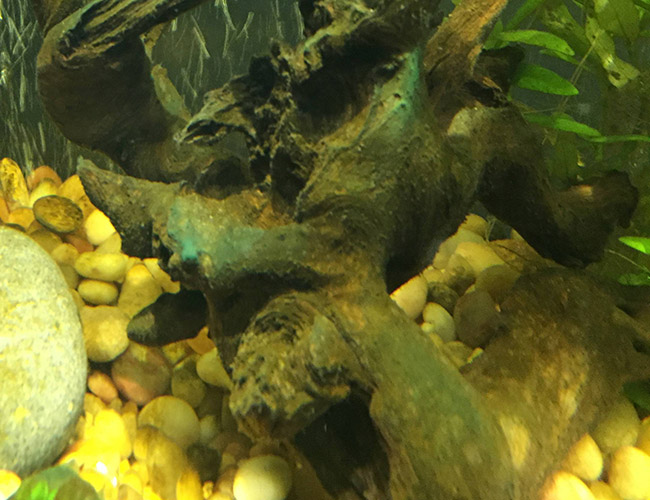
When blue-green algae first appears in your tank, it can easily be mistaken for other algae, such as fuzz algae or even green hair algae.[4]
But don't worry, blue-green algae has unique characteristics that make it easy to tell it apart from the other types of algae.
First, blue-green algae clumps together. If you attempt to pick it up by hand, you will be able to remove entire patches of it…

Ugh… Disgusting…
Speaking of disgusting, you can identify some types of blue-green algae by it's odor. It smells bad. Really bad. In fact, blue-green algae might be the reason why your fish tank stinks!
If I had to describe the odor, I would have to say that it smells similar to rotting plants – like a swamp.
However, not all types of blue-green algae have a scent.
If you still aren't sure that you are dealing with blue-green algae, then I have a simple test you can do.
Take a little bit of your aquarium water and fill a bucket so that it is at least one inch full. Next, take a few blobs of what you think is blue-green algae and place them at the bottom of the bucket.
Now, let it sit for 24 hours. If you notice it spread, then you can rule out any other type of algae. Your aquarium has a blue-green algae bloom!
Below you see spots of blue-green algae at the bottom of a bucket…

See that green glow around each of the dark clumps? Well, that wasn't there 24 hours ago. This is the blue-green algae beginning to spread.
Algae doesn't spread in the same manner. So, if you see this, you can be certain you are dealing with blue-green algae.
What causes blue-green algae to appear?
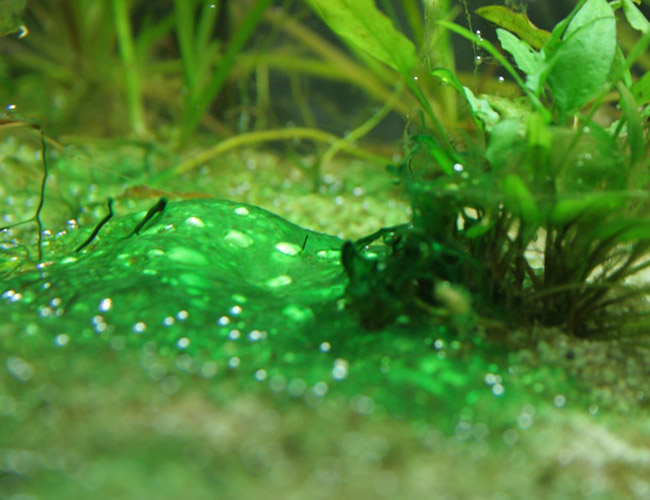
While blue-green algae typically appears in planted tanks, it has also been spotted in tanks without live plants.
Unfortunately, blue-green algae is not very well understood. And as a result, a lot of conflicting information exists as to what actually causes blue-green algae to appear in the first place.
Some say that the cyanobacteria is present in the local water supply, and is introduced into your tank during water changes.
Others blame Ammonia, excess light, poor water circulation, and even dirty substrates and filters.
Given that the above are common factors in an unhealthy tank with messed up parameters, it's unsurprising that these are often present when blue-green algae appears out of nowhere.
However, there is a cause that many experts agree on…
Low nitrates.[5]
If your nitrate levels read zero, or are particularly low, you may be inviting blue-green algae to your tank. Check your nitrate levels with a test kit.
Now, there are numerous theories as to why low nitrate levels cause blue-green algae to appear. Some say it's because plants and algae eat nitrates while blue-green algae doesn't. Because of this, blue-green algae likes a nitrate-free environment because there is no food for these other plants that would compete with it.
If you have a blue-green algae bloom, and your planted tank is low in nitrates, raise them to around 20 parts per million (PPM). Once the blue-green algae is removed, this level of nitrates should prevent it from coming back.
Like most algae, a well-maintained tank with stable water parameters seems to be the best method of preventing blue-green algae from taking over your tank.
Will blue-green algae harm your fish?
It's no secret that many types of blue-green algae are toxic.[6]
So surely you don't want your fish near the stuff.
Don't worry…
Your fish won't actually eat it. In fact, at the time of writing this, there are no known fish or invertebrates that consume blue-green algae.
This is a good thing – your fish are smart enough not to eat something that might harm them. But it also means you can't rely on a clean-up crew to get rid of the blue-green algae for you – plecos, shrimp and snails won't touch it.
Plants on the other hand, aren't so lucky…
Will blue-green algae harm your plants?

Yes, blue-green algae can be deadly to plants.
Blue-green algae spreads quickly. And as it does, it will cover your plants in a slimy film that is thick enough to block out light.
Now, I don't need to tell you that plants need light for energy. Without it, they will eventually die.
So if you leave your blue-green algae infestation to grow, you are putting your plants at risk.
How do you get rid of blue-green algae?
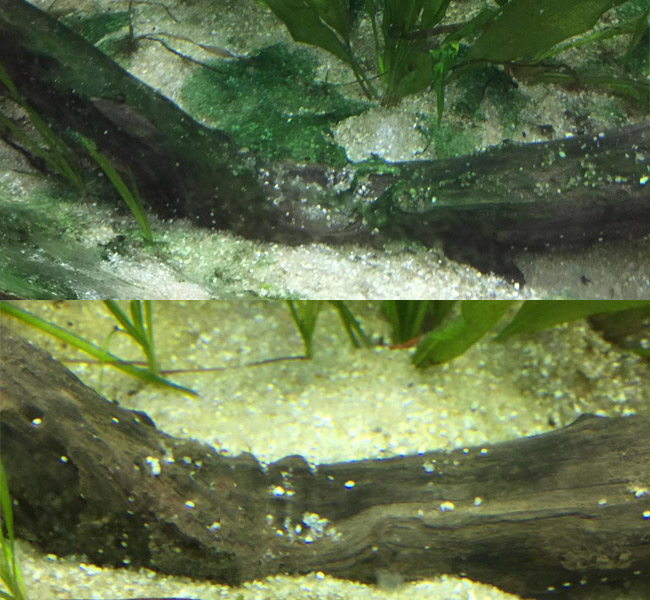
Blue-green algae is ugly. And if you don't treat it, it will soon take over your aquarium.
You want it gone, and you want it gone now!
Unfortunately, because blue-green algae isn't actually an algae, traditional algae killers like Seachem Excel won't do much in terms of killing it.
Blacking out your aquarium will have mixed results. And, feeding your fish less will have no impact.
So, how do you get rid of blue-green algae?
Today, I am going to take you through the different ways you can get rid of blue-green algae. And best of all, these methods actually work.
Let's start with my personal favorite…
1. UltraLife Blue-Green Slime Stain Remover
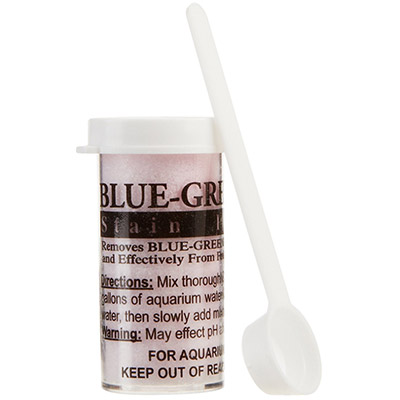
It might be called a "stain remover," but this stuff stops a full-blown blue-green algae bloom in its tracks. Best of all, it won't harm your biological filter, fish or plants – a major problem with harsher chemical treatments like Erythromycin or Maracyn.
To say that this is a low-effort way of getting rid of blue-green algae is an understatement. Simply perform a water change, add a dose and wait for the slime stain remover to work.
At first, this product is disappointing. You add it, and it looks like nothing is happening. But about a week later, the blue-green algae will begin to melt away – like magic!
You will know when your blue-green algae is starting to die off because it dries out and turns a dark, almost black color.
Like with any chemical you add to your aquarium, make sure that you follow the instructions exactly and monitor your water parameters during treatment.
2. Hydrogen Peroxide (H202)
This one is best left to the experts. If you intend to dose or spot-treat with hydrogen peroxide, I highly recommend following the advice from someone who is experienced with this treatment because…
If you are not careful, you can kill off all the good bacteria in your biological filter and harm your fish and plants.
Use this guide for some basic guidelines on dosing with hydrogen peroxide.
3. Manual Removal
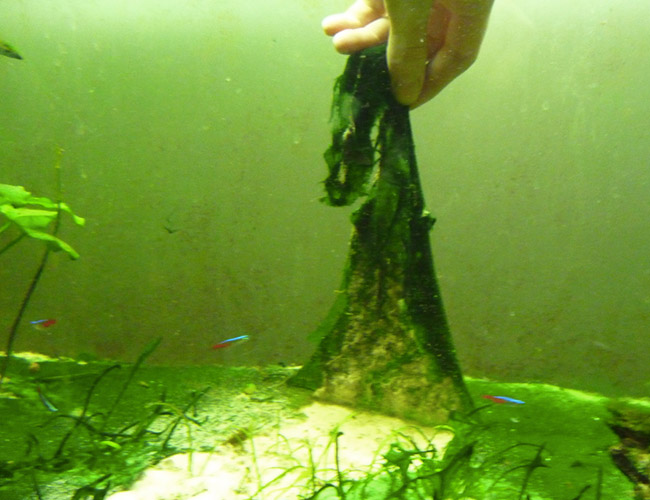
Because blue-green algae sticks together and comes off in sheets, you have the option to manually remove it from your aquarium.
But before you get your hands wet, there is one thing you should know:
This is my least favorite way of removing blue-green algae.
You see, as you pull at the blue-green algae, small pieces fall off and float around your tank. And, it doesn't take long for these small chunks to grow into large sheets of algae.
So, if you are not careful with how you remove it, you could be helping the blue-green algae spread faster than before.
If you really want to go down this route, use a turkey baster. This allows you to suck up small clumps of blue-green algae without bits breaking off and floating around your tank.
While manual removal may control blue-green algae, it doesn't kill it. Any small piece left behind will grow again.
Conclusion
Let's be honest, blue-green algae is a menace.
It can turn your bright and colorful aquarium into a slimy, dark-green wasteland.
While its exact causes are not clear, it can be removed without too much difficulty using the methods listed in this guide.
How do you get rid of blue-green algae? Let me know in the comments below!
Source: https://fishlab.com/blue-green-algae/
0 Response to "Is There Blue Green Algae in Groton Ma"
Post a Comment